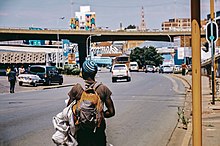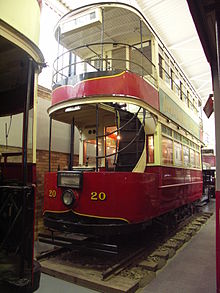Transport in South Africa
Most people in South Africa use informal minibus taxis as their primary mode of transport. BRT, a bus service, has been implemented in some South African cities to provide more formalised and safer public transport services. These systems have been criticised due to their significant capital and operating costs. South Africa has many major ports, including Cape Town, Durban, and Port Elizabeth.
Department of Transport
[edit]The Department of Transport is responsible for the regulation of all transportation in South Africa, including public transport, rail transportation, civil aviation, shipping, freight, and motor vehicles. According to the department's vision statement, "Transport [is] the heartbeat of South Africa's economic growth and social development!"[1]
Roads
[edit]Road network and freeways
[edit]Apartheid led to a massive expansion of South Africa's road and bus systems to transport black workers from bantustans they had been forcibly removed to from to urban areas. As a result of the severe wealth inequality under apartheid, the apartheid government heavily subsidised bus systems at the rate of $1,000 per commuter. For bantustans such as KwaNdebele, the apartheid regime provided a higher bus subsidy than their gross domestic product.[2]
The national speed limit is 60 km/h in residential areas and 120 km/h on national roads, freeways, and motorways.


In 2002, South Africa had 362,099km of highways and 73,506km of paved (including 239km of expressways).[3]
The term freeway in South Africa differs from most other parts of the world. A freeway is a road where certain restrictions apply.[4] The following are forbidden from using a freeway:
- a vehicle drawn by an animal;
- a pedal cycle (such as a bicycle);
- a motor cycle having an engine with a cylinder capacity not exceeding 50 cm3 or that is propelled by electrical power;
- a motor tricycle or motor quadrucycle;
- pedestrians
Drivers may not use hand signals on a freeway (except in emergencies), and the minimum speed on a freeway is 60 km/h (37 mph). Drivers in the rightmost lane of multi-carriageway freeways must move to the left if a faster vehicle approaches from behind to overtake.
Despite the popular opinion that "freeway" means a road with at least two carriageways, single-carriageway freeways exist.[5] The Afrikaans translation of freeway is snelweg (literally fast road or expressway).
Minibus Taxis
[edit]Minibus Taxis are the predominant form of transport for people in urban areas of South Africa.[6] This is due to their availability and affordability to the public.[7] Most minibus taxis are not subsidised by the state and the taxi industry is notorious for using vehicles that are not well maintained.[8] Because many taxi owners own just a few taxis and each owner may choose to manage their business differently, there is not much known as to the inner workings of the industry. Since 1994, there have been efforts to formalise the industry, but as taxi organisations often don't abide by labour regulations, relationships between taxi operators and the state are often strained.
In 2021, there were 349,671 registered minibuses.[9] In 2021, there were 73,953 unroadworthy or unlicensed minibuses.[9]

Cape Town and MyCiTi IRT
[edit]The City of Cape Town has clarified that developing public transportation is a priority to achieve its long-term developmental goals. As such, the city has planned the development of an Integrated Rapid Transit (IRT) system called "MyCiTi IRT". In 2007, the construction of this system began with the implementation of Cape Town's "Bus Rapid Transit" system. This first phase has been designed to enable easy integration of other forms of public transport – ranging from cycling to South Africa's famous minibuses in later stages of the IRT development[10] – including rail transit, seen currently as "the backbone of public transportation in Cape Town."[11]
Road transport safety
[edit]South Africa's road traffic system might be less effective than most industrial countries, but it is not worse than other African nations. South Africa has an institutional framework for road safety led by the Road Traffic Management Corporation. South African laws follow global best practices, including speed limits, drink-driving, motorcycle helmets, seat-belts, child restraints, and mobile phone use.[12]
South Africa counts 26 deaths each year for 100,000 people (260 per million), a higher rate than the global average of 18 per 100,000 (180 per million).[12]
In 2021, the country recorded 12,541 road fatalities for 11,726,476 vehicles (7.6 million motor vehicles and over 2.6 million light delivery vehicles/bakkies).[13] with "motor vehicle" including vehicles such as motorcycles and motor tricycles.
People killed in road accidents are mostly pedestrians with a percentage of 37.6%. Passengers suffer 32% of fatalities and drivers 27%.[14]
58% of road deaths are attributed to alcohol use, which makes alcohol a leading factor in such fatalities.[12] South Africa had the highest number of drunk driving incidents according to a WHO survey.[14]
Pedestrians may be affected by a 60 km/h posted speed limit in residential and urban areas, a speed so excessive that it reduces pedestrians' chance of survival.[14]
According to some sources, 31% of South African drivers wear seatbelts,[12] while other sources claim a 45 to 60% compliance rate for drivers.[14]
Vehicle maintenance issues cause 9% of road accidents, including tyres, brakes, and lights issues.[14] When vehicle safety is involved, tyres are the first issue in 41% of vehicle factors.[9]
When a crash is considered major, the crash type is often a head-on collision (44%), multi-vehicle (16%) or a T-Bone collision (15%).[9]
Railways
[edit]In 2000, South Africa had 20,384 km of rail transport, all of it narrow gauge. 20,070 km was 1,067 mm (3 ft 6 in) gauge (9,090 km of that electrified), with the remaining 314 km 610 mm (2 ft) gauge. The operation of the country's rail systems is accomplished by Transnet subsidiaries Transnet Freight Rail, Shosholoza Meyl, Metrorail, Transnet Engineering, Protekon et al.
A feasibility study is to be conducted into the construction of a 720 km of 1,435 mm (4 ft 8+1⁄2 in) (standard gauge) line from Johannesburg to Durban for double-stack container trains.[15]
On 2010-06-07 the Gautrain opened between Oliver R Tambo International Airport (ORTIA) and Sandton. This is the first stage of a standard gauge passenger line connecting Johannesburg, Pretoria and ORTIA.[16]
Links exist to Botswana, Lesotho, Namibia, Eswatini, and Zimbabwe. Railways linking Mozambique are under repair.
Transportation systems in nearby countries
[edit] Angola
Angola Tanzania same gauge as far as Dar es Salaam – transshipment to 1,000 mm (3 ft 3+3⁄8 in) gauge at Kidatu
Tanzania same gauge as far as Dar es Salaam – transshipment to 1,000 mm (3 ft 3+3⁄8 in) gauge at Kidatu Malawi
Malawi Congo
Congo Botswana
Botswana Lesotho
Lesotho Mozambique, under repair
Mozambique, under repair Namibia
Namibia Eswatini
Eswatini Zambia
Zambia Zimbabwe
Zimbabwe
Airports
[edit]Runways in South Africa
[edit]| Runway | <914 m | 914/1 523 m | 1 524/2 437 m | 2 438/3 047 m | >3 047 m | Total |
|---|---|---|---|---|---|---|
| Paved | 11 | 67 | 50 | 5 | 10 | 143 |
| Unpaved | 252 | 298 | 34 | 584 |
International Airports and Airlines
[edit]South Africa has international airports in four cities: Johannesburg, Cape Town, Durban and Nelspruit. The main international airports are in Johannesburg and, to a lesser extent, Cape Town. Nelspruit's international airport mainly serves travellers en route to the Kruger National Park.[17]
Many international airlines travel to South Africa, giving travellers many options. These include British Airways, Delta Air Lines, Ethiopian Airways, Kenya Airways, Qantas, Singapore Airlines, South African Airways, Swiss International Air Lines, Thai Airways, Turkish Airlines, Virgin Atlantic, Air Mauritius, Air Botswana, Air France, KLM, Lufthansa, Alitalia, Malaysia Airlines and Qatar Airways.[18]
Water
[edit]South Africa's major ports and harbours are Cape Town, Durban, East London, Mossel Bay, Port Elizabeth, Richards Bay and Saldanha Bay. In 2006, the new port is to open: Ngqura, at Coega, which is 20 km northeast of Port Elizabeth. The administration and operation of the country's port facilities are done by two subsidiaries of Transnet, the Transnet National Ports Authority and South African Port Operations (SAPO).
As of March 2018, the merchant marine consisted of 15 ships totalling 431,133 GT.
Pipelines
[edit]There are 931 km of crude oil pipeline transport, 1,748 km for other petroleum products, and 322 km for natural gas. Petronet, a subsidiary of Transnet, which in turn is majority-owned by the government, is principally responsible for the operation of South Africa's pipelines.
Tramways
[edit]
Many urban tramway systems operated in South Africa but no longer do so. The last system (in Johannesburg) began in 1890 as Rand Tramway (electrified in 1906) and ceased operations in 1961.[19]
See also
[edit]References
[edit]- ^ "Home – Department-of-Transport".
- ^ Clark, Nancy L.; Worger, William H. (2016). South Africa: the rise and fall of apartheid (Third ed.). ISBN 978-1-138-12444-8. OCLC 883649263.
- ^ "CIA World Factbook". 19 January 2022.
- ^ Road Traffic Act No 29 of 1989 Archived 17 June 2011 at the Wayback Machine
- ^ "Transportation: Roads". South Africa:– Stats and Facts. Archived from the original on 27 July 2011. Retrieved 15 June 2010.
- ^ "Minibus Taxis and Road Safety". Arrive Alive. Retrieved 14 September 2018.
- ^ "The minibus taxi industry in South Africa: A servant for the urban poor?". Polity.org.za. Retrieved 14 September 2018.
- ^ "Minibus taxis | Getting Around | Johannesburg". inyourpocket.com. Retrieved 14 September 2018.
- ^ a b c d "State of Road Safety Report" (PDF). www.rtmc.co.za. Road Traffic Management Corporation. Retrieved 26 July 2024.
- ^ "IRT overview". Archived from the original on 21 January 2016. Retrieved 21 October 2015.
- ^ "MyCiTi IRT: Project information". Archived from the original on 23 September 2015. Retrieved 21 October 2015.
- ^ a b c d "2021-04 – South Africa bottom of the class for road safety? Here's why this isn't true – Wits University".
- ^ "AA's 2022 entry-level vehicle safety report proves encouraging". 2 August 2022.
- ^ a b c d e "Road Safety in the South African Context".
- ^ International Railway Journal, 2005-01-03
- ^ Baumann, Julius (9 June 2010). "South Africa: Gautrain Gives Joburg a World-Class Touch". allAfrica.com. Archived from the original on 10 June 2010.
- ^ "SA Airports – Location, Contact Details, Telephone Numbers". sa-airlines.co.za. Retrieved 14 December 2018.
- ^ "International Airlines". Domestic Flights South Africa. Retrieved 14 December 2018.
- ^ "The role of transport in the rise and decline of the Johannesburg CBD, 1886-2001" (PDF). Archived from the original (PDF) on 17 November 2009. Retrieved 28 June 2011.
![]() This article incorporates public domain material from The World Factbook. CIA.
This article incorporates public domain material from The World Factbook. CIA.

